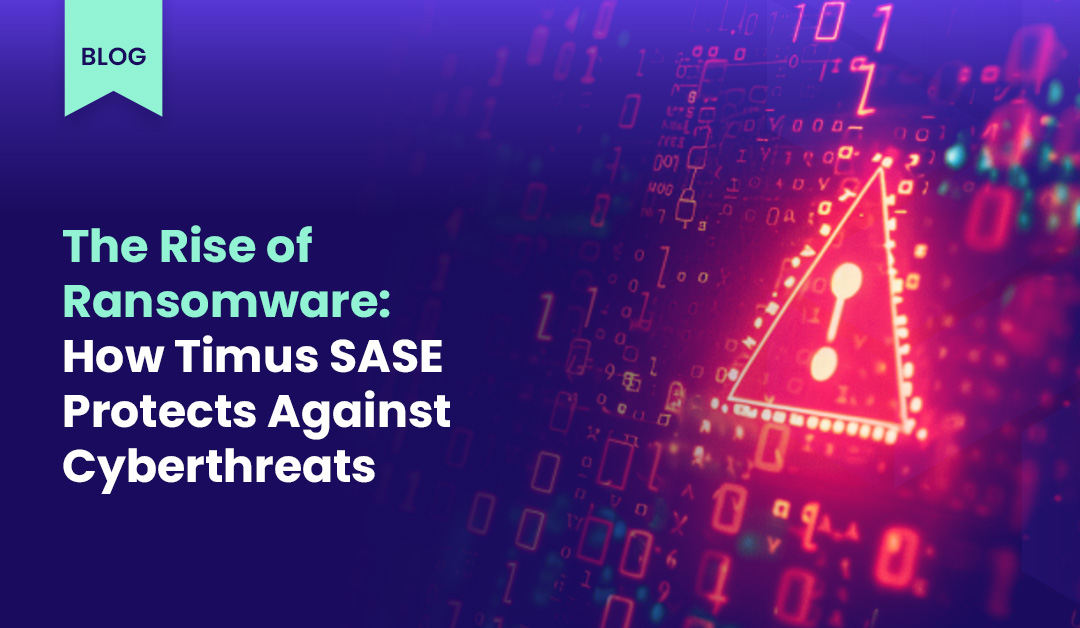The Rise of Ransomware: How Timus SASE Protects Against Cyberthreats
Ransomware continues to be a formidable challenge for businesses worldwide, with small and medium-sized businesses (SMBs) bearing a significant brunt of these cyberattacks. The Q4 2024 Travelers' Cyber Threat Report sheds light on the evolving tactics of ransomware groups and underscores the pressing need for SMBs to adopt cybersecurity frameworks like Secure Access Service Edge (SASE) and Zero Trust Network Access (ZTNA).
Author
Date
Category
All Categories
- AI-powered security
- Attacks & Threats
- Cybersecurity
- Hybrid Cloud
- Network
- Network Firewall
- Network Protection
- News
- Remote Workforce
- Security
- Zero Trust
Contents
Popular Posts
Product
Join the Newsletter

Ransomware continues to be a formidable challenge for businesses worldwide, with small and medium-sized businesses (SMBs) bearing a significant brunt of these cyberattacks. The Q4 2024 Travelers’ Cyber Threat Report sheds light on the evolving tactics of ransomware groups and underscores the pressing need for SMBs to adopt cybersecurity frameworks like Secure Access Service Edge (SASE) and Zero Trust Network Access (ZTNA).
Ransomware on the Rise
The fourth quarter of 2024 witnessed an unprecedented surge in ransomware incidents. According to the report, 1,663 companies were posted on leak sites during this period, marking a 32% increase from the previous quarter. Notably, November alone accounted for 629 attacks, highlighting a seasonal spike in cybercriminal activities. Over the entire year, 55 new ransomware groups emerged—a 67% increase compared to 2023—indicating a rapid proliferation of smaller, more agile players in the cybercrime ecosystem.
VPN Vulnerabilities: A Gateway for Attackers
A significant portion of these ransomware attacks exploited vulnerabilities in Virtual Private Networks (VPNs). In Q3 2024, attackers targeting VPNs accounted for 28% of ransomware incidents. This trend underscores a critical weakness in traditional network security models that rely heavily on perimeter defenses. Compromised VPN credentials or unpatched VPN appliances provide cybercriminals with direct access to internal networks, bypassing conventional security measures.
Inside the Ransomware Operations
Recent leaks have offered a rare glimpse into the inner workings of ransomware groups. For instance, the Black Basta ransomware group’s internal communications reveal that these organizations operate much like legitimate businesses, with structured hierarchies, performance incentives, and strategic planning sessions. Such insights demystify the operations of these cybercriminals and highlight the organized nature of their illicit activities.
The Imperative for SMBs: Embracing SASE and Zero Trust
Given the escalating threat landscape, it’s imperative for SMBs to reassess their cybersecurity strategies. Traditional models that focus on securing the network perimeter are increasingly inadequate against sophisticated ransomware tactics. This is where frameworks like Secure Access Service Edge (SASE) and Zero Trust come into play.
Understanding SASE
SASE is a cybersecurity concept that converges network access and network security to support the dynamic, secure access needs of organizations. It delivers services like always-on VPNs with ZTNA, secure web gateways, firewall-as-a-service, and more, all integrated into a single, cloud-native service model. This approach ensures consistent security policies and protections, regardless of where users or applications are located.
The Zero Trust Philosophy
Zero Trust operates on the principle that no entity—whether inside or outside the network—should be trusted by default. Every access request is thoroughly vetted, requiring verification of the user’s identity, device integrity, and contextual factors before granting access. This minimizes the risk of lateral movement within the network, a common tactic employed by ransomware once initial access is gained.
Implementing SASE and Zero Trust with Timus Networks
For SMBs looking to bolster their defenses, partnering with providers like Timus Networks can be a game-changer. Timus Networks’ flagship product, Timus SASE, comes standard with Zero Trust fundamentals, providing a comprehensive security posture that is both robust and adaptable to the unique needs of SMBs.
Conclusion
The insights from the Q4 2024 Travelers’ Cyber Threat Report serve as yet another stark reminder of the evolving ransomware threat landscape. For SMBs, adopting security frameworks like SASE and Zero Trust is no longer optional but a necessity to safeguard against these pervasive cyberthreats. By embracing these modern approaches, SMBs can enhance their resilience and protect their valuable assets in an increasingly hostile digital environment.
References
Corvus Cyber Insurance:
Corvus Insurance. (2024, Q4). Travelers’ Cyber Threat Report. Retrieved from https://www.corvusinsurance.com/blog/q4-2024-travelers-cyber-threat-report
BankInfoSecurity:
Mickelberg, K. (2024, March 21). Puncturing Ransomware’s Mystique: Leaks Show Office Life. BankInfoSecurity. Retrieved from https://www.bankinfosecurity.com/puncturing-ransomwares-mystique-leaks-show-office-life-a-27869
FAQ
Zero Trust security ensures that no user, device, or application is trusted by default, reducing the risk of ransomware, phishing attacks, and unauthorized access. By enforcing strict identity verification, least-privilege access, and continuous security monitoring, it protects remote workforces, secures sensitive data, and strengthens overall network security.
Traditional VPNs are vulnerable to credential theft, unpatched exploits, and lateral movement of cyberthreats. A cloud-native security solution with Zero Trust Network Access (ZTNA) provides always-on, identity-based access controls, ensuring secure remote work and preventing data breaches.
SASE integrates Zero Trust security, firewall-as-a-service, and secure web gateways into a single cloud-delivered solution, eliminating the need for fragmented security tools. It enables secure remote work, simplifies network security, and reduces cybersecurity risks for businesses of all sizes.
Get Started with Timus
Zero Trust. Adaptive Cloud Firewall. Secure Remote Access. In one.
